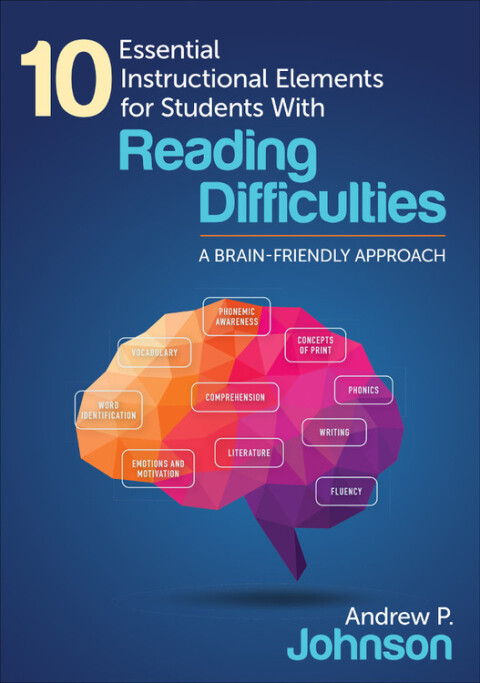Description
Efnisyfirlit
- Acknowledgments
- About the Author
- Introduction
- Context
- Code First or Meaning First
- Code First
- Meaning First
- Top Down
- Tools in Your Teaching Toolbox
- Audience
- Section I.Understanding the Reading Process
- Chapter 1. Creating Meaning With Print: The Neurocognitive Model
- Understanding Reading
- The Phonological Processing Model of Reading
- The Neurocognitive Model of Reading
- Creating Meaning With Print
- Reading: A Neurological Perspective
- The Three Cueing Systems
- 1. Semantic
- 2. Syntactic
- 3. Grapho-Phonetic
- The Relative Unimportance of Letters
- The Neurocognitive Process
- Speed and Efficiency
- The Meaninglessness of Individual Words
- Last Word
- Chapter 2. Eye Movement and Neural Pathways
- Eye Movement During Reading
- Your Dancing Eyeballs
- Scanner
- Perception
- Understanding Our Learning Organ
- An Integrated Whole
- Creating Neural Networks
- We Create Our Own Reality
- Last Word
- Chapter 3. Understanding Reading From a Cognitive Perspective
- The Difference Between Brain and Mind
- The Information Processing Model
- Perceptions—Sensory Resister—Sense Memory
- Short-Term Memory
- Holding More Bits
- Learning to Read
- Working Memory
- Automaticity
- Long-Term Memory
- The Two-Way Flow of Information
- LTM to STM
- LTM to Perception
- Schema Theory and Reading
- Last Word
- Section II.Diagnosing Reading Problems, Documenting Progress, and Planning Instruction
- Chapter 4. Diagnosis and Documentation
- Diagnosing the Problem
- Limitations of Standardized Tests
- Diagnostic Reading Inventory
- Graded Word Lists
- Graded Reading Passages
- Qualitative Data Analysis
- Miscue Analysis
- Assessing Comprehension
- Story Retelling
- Maze
- Putting It Together
- Three Deficit Areas
- Fluency
- Word Identification
- Comprehension
- Planning for Instruction
- Reliability, Validity, Intervention Plans, and IEPs
- Last Word
- Chapter 5. Reading Lessons
- SRE Lesson
- Lesson Purpose Statement
- Pre-Reading Activity
- During-Reading Activity
- Post-Reading Activity
- Guided Reading Lesson
- Planning a Guided Reading Lesson
- A Note About Guided Reading
- Shared Reading Lesson
- During-Reading Strategies
- ERT
- Every-Other
- Planning a Shared Reading Experience
- Last Word
- Section III.10 Instructional Elements
- Chapter 6. 10 Elements of Reading Instruction
- No Magical Programs
- Comprehensive Reading Instruction
- 10 Essential Elements for Reading Instruction
- Teaching Reading With the Brain in Mind
- 1. Engagement
- 2. Repetition
- 3. Input Quantity
- 4. Coherence
- 5. Timing
- 6. Error Correction
- 7. Emotional States
- Last Word
- Chapter 7. Emergent Literacy: Concepts of Print and Phonemic Awareness
- Approaches to Early Literacy Instruction
- Code First
- Meaning First
- Skills Instruction in a Meaning-First Approach
- Developmentally Appropriate Instruction
- Whole-to-Part-to-Whole Instruction
- Creating the Conditions for Early Literacy Learning
- Concepts of Print
- Phonemic-Phonics Hybrid Activities
- Phonemic-Phonics Hybrids for Older Students
- Last Word
- Chapter 8. Emotions and Motivation
- Emotions
- Understanding
- Honesty, Trust, and Relationship
- The Value-Expectancy Theory of Motivation
- Value
- Attainment Value
- Intrinsic Value
- Utility Value
- Expectancy
- Some Basic Strategies
- Last Word
- Chapter 9. Literature and Instructional Approaches
- Strategies for Promoting Voluntary Reading
- Instructional Approaches
- Language Experience Approach
- Self-Selected or Reading Workshop Approach
- Basal-Reading Workshop Approach
- The Four Blocks™ Approach
- Last Word
- Chapter 10. Phonics
- Fawnix
- Tips for Developing Phonetic Cueing Systems
- Systematic Phonics Instruction
- Types of Phonics Instruction
- 14 Strategies
- Last Word
- Appendix: Phonics Checklist
- Chapter 11. Strategies for Developing Word Identification Skills
- Terms and Concepts Related to Word Identification
- Recognizing and Identifying Words
- Strategies and Skills
- Context Clues: The Semantic Cueing System
- Cloze
- Maze
- Word Order and Grammar: The Syntactic-Cueing System
- Word Parts
- Word Parts: A Strategy for Identifying Words
- Word Parts: Pedagogical Strategies
- Phonograms: Pedagogical Strategies
- Morphemic Analysis
- Morphemic Analysis: A Strategy for Identifying Words
- The Most Common Prefixes and Suffixes
- Teaching About Prefixes
- Teaching About Suffixes
- Root Words
- Activities for Developing Morphemic Recognition
- Sight Words
- Last Word
- Chapter 12. Fluency
- Reading Fluency
- Neural Pathways and Networks
- Strategies for Enhancing Reading Fluency
- Wide Reading
- Repeated Reading
- Other Fluency Strategies
- Avoid Round-Robin Reading
- Last Word
- Chapter 13. Comprehension of Narrative Text
- Comprehension Basics
- Teaching Tips
- Activities Organized by Cognitive Process
- Recognize Story Grammar
- Predict
- Visualize
- Infer
- Compare
- Evaluate
- Analyze
- Identify Cause-Effect
- Identify Supporting Details
- Last Word
- Chapter 14. Comprehension of Expository Text
- Expository Text
- Teacher Pre-Reading Strategies
- Study-Skill Strategies
- Basic Study-Skill Strategies
- Helping All Teachers Become Teachers of Reading
- Pedagogical Strategies to Develop Cognitive Processes Related to Comprehension
- Last Word
- Chapter 15. Vocabulary
- Attending to Vocabulary
- Word Learning
- Levels and Types of Word Knowledge
- Volume and Vocabulary
- General Principles for Developing Students’ Vocabulary
- Strategies for Developing Students’ Vocabulary
- Visual Displays and Graphic Organizers
- Last Word About Words
- Chapter 16. Writing
- The Why and How of Writing
- 10 General Guidelines
- Specific Strategies
- Last Word
- Epilogue
- References
- Index






Reviews
There are no reviews yet.